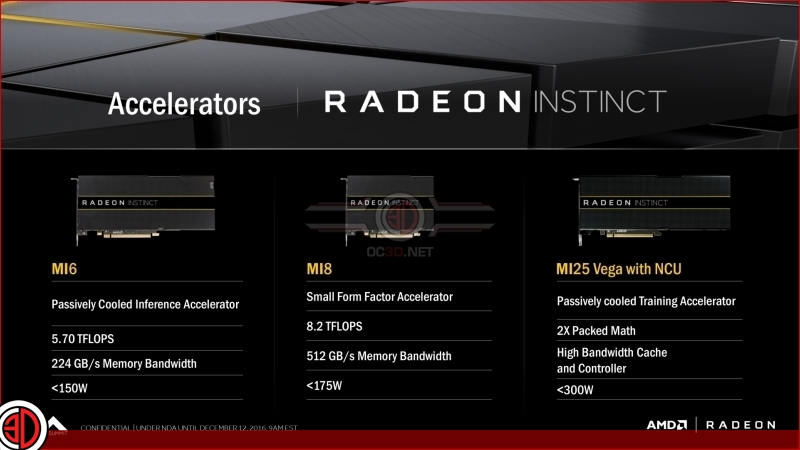Linux DRM driver update reveals Vega specifications
Linux DRM driver update reveals Vega specifications
When compared to AMD’s Polaris 10 RX 570, Vega 10 will feature 2x the Stream processors, texture mapping units and render output units, which when combined with Vega’s architectural changes should create a very powerful GPU.
Â
| Â | RX 570 | RX 580 | RX Vega |
| GPU | Polaris 10 Pro | Polaris 10 XT | Vega 10 |
| Process node | 14nm | 14nm | 14nm |
| Shade Engines | 4 | 4 | 4 |
| CUs per shader Engine | 8 | 9 | 16 |
| Shaders Per CU | 64 | 64 | 64 (expected) |
| Stream Processors | 2048 | 2304 | 4096 |
| Performance (FP32) | 5.095 TFLOPs | 6.175 TFLOPs | 12.5 TFLOPs |
| Performance (FP16) | 5.095 TFLOPs | 6.175 TFLOPs | 25 TFLOPs |
| Render Output Units | 32 | 32 | 64 |
| Texture Mapping units | 126 | 144 | 256 |
| Hardware Threads | 4 | 4 | 8 |
| Memory Interface | 256-bit | 256-bit | 2048-bit |
| Memory | 4/8GB GDDR5 | 4/8GB GDDR5 | 8GB HBM2 |
Â
Looking at AMD’s previously announced Vega Instinct MI25, we see that AMD claims that the GPU offers around 12.5TFLOPs of FP32 compute performance given AMD’s MI naming scheme. Â Â
If AMD’s new NCUs come with the same stream processor count as AMD’s GCN/Polaris GPUs, this will place Vega’s clock speeds at around  1526MHz, which is a significant boost when compared to both Polaris and Fiji.  As you can see below, AMD’s MI25 accelerator is said to be passively cooled, which means that Vega should run cool and that higher clock speeds should be possible if users are willing to increase Vega’s heat output.Â
As you can see below, AMD’s MI25 accelerator is said to be passively cooled, which means that Vega should run cool and that higher clock speeds should be possible if users are willing to increase Vega’s heat output.Â
Â
At this time these specifications remain unconfirmed by AMD, but there is no reason for AMD to lie in their Linux submissions. For the most part, these specifications confirm what was already expected from Vega, which is a high GPU core count and clock speed that are higher than what is available with AMD’s existing Polaris offerings.Â
Â
You can join the discussion on Vega’s specifications on the OC3D Forums.Â
Â
Linux DRM driver update reveals Vega specifications
When compared to AMD’s Polaris 10 RX 570, Vega 10 will feature 2x the Stream processors, texture mapping units and render output units, which when combined with Vega’s architectural changes should create a very powerful GPU.
Â
| Â | RX 570 | RX 580 | RX Vega |
| GPU | Polaris 10 Pro | Polaris 10 XT | Vega 10 |
| Process node | 14nm | 14nm | 14nm |
| Shade Engines | 4 | 4 | 4 |
| CUs per shader Engine | 8 | 9 | 16 |
| Shaders Per CU | 64 | 64 | 64 (expected) |
| Stream Processors | 2048 | 2304 | 4096 |
| Performance (FP32) | 5.095 TFLOPs | 6.175 TFLOPs | 12.5 TFLOPs |
| Performance (FP16) | 5.095 TFLOPs | 6.175 TFLOPs | 25 TFLOPs |
| Render Output Units | 32 | 32 | 64 |
| Texture Mapping units | 126 | 144 | 256 |
| Hardware Threads | 4 | 4 | 8 |
| Memory Interface | 256-bit | 256-bit | 2048-bit |
| Memory | 4/8GB GDDR5 | 4/8GB GDDR5 | 8GB HBM2 |
Â
Looking at AMD’s previously announced Vega Instinct MI25, we see that AMD claims that the GPU offers around 12.5TFLOPs of FP32 compute performance given AMD’s MI naming scheme. Â Â
If AMD’s new NCUs come with the same stream processor count as AMD’s GCN/Polaris GPUs, this will place Vega’s clock speeds at around  1526MHz, which is a significant boost when compared to both Polaris and Fiji.  As you can see below, AMD’s MI25 accelerator is said to be passively cooled, which means that Vega should run cool and that higher clock speeds should be possible if users are willing to increase Vega’s heat output.Â
As you can see below, AMD’s MI25 accelerator is said to be passively cooled, which means that Vega should run cool and that higher clock speeds should be possible if users are willing to increase Vega’s heat output.Â
Â
At this time these specifications remain unconfirmed by AMD, but there is no reason for AMD to lie in their Linux submissions. For the most part, these specifications confirm what was already expected from Vega, which is a high GPU core count and clock speed that are higher than what is available with AMD’s existing Polaris offerings.Â
Â
You can join the discussion on Vega’s specifications on the OC3D Forums.Â
Â




